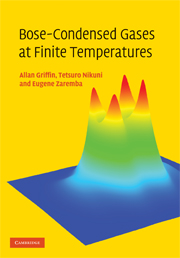Book contents
- Frontmatter
- Contents
- Preface
- 1 Overview and introduction
- 2 Condensate dynamics at T = 0
- 3 Coupled equations for the condensate and thermal cloud
- 4 Green's functions and self-energy approximations
- 5 The Beliaev and the time-dependent HFB approximations
- 6 Kadanoff–Baym derivation of the ZNG equations
- 7 Kinetic equation for Bogoliubov thermal excitations
- 8 Static thermal cloud approximation
- 9 Vortices and vortex lattices at finite temperatures
- 10 Dynamics at finite temperatures using the moment method
- 11 Numerical simulation of the ZNG equations
- 12 Simulation of collective modes at finite temperature
- 13 Landau damping in trapped Bose-condensed gases
- 14 Landau's theory of superfluidity
- 15 Two-fluid hydrodynamics in a dilute Bose gas
- 16 Variational formulation of the Landau two-fluid equations
- 17 The Landau–Khalatnikov two-fluid equations
- 18 Transport coefficients and relaxation times
- 19 General theory of damping of hydrodynamic modes
- Appendix A Monte Carlo calculation of collision rates
- Appendix B Evaluation of transport coefficients: technical details
- Appendix C Frequency-dependent transport coefficients
- Appendix D Derivation of hydrodynamic damping formula
- References
- Index
18 - Transport coefficients and relaxation times
Published online by Cambridge University Press: 06 October 2009
- Frontmatter
- Contents
- Preface
- 1 Overview and introduction
- 2 Condensate dynamics at T = 0
- 3 Coupled equations for the condensate and thermal cloud
- 4 Green's functions and self-energy approximations
- 5 The Beliaev and the time-dependent HFB approximations
- 6 Kadanoff–Baym derivation of the ZNG equations
- 7 Kinetic equation for Bogoliubov thermal excitations
- 8 Static thermal cloud approximation
- 9 Vortices and vortex lattices at finite temperatures
- 10 Dynamics at finite temperatures using the moment method
- 11 Numerical simulation of the ZNG equations
- 12 Simulation of collective modes at finite temperature
- 13 Landau damping in trapped Bose-condensed gases
- 14 Landau's theory of superfluidity
- 15 Two-fluid hydrodynamics in a dilute Bose gas
- 16 Variational formulation of the Landau two-fluid equations
- 17 The Landau–Khalatnikov two-fluid equations
- 18 Transport coefficients and relaxation times
- 19 General theory of damping of hydrodynamic modes
- Appendix A Monte Carlo calculation of collision rates
- Appendix B Evaluation of transport coefficients: technical details
- Appendix C Frequency-dependent transport coefficients
- Appendix D Derivation of hydrodynamic damping formula
- References
- Index
Summary
In Chapter 17, we derived two-fluid hydrodynamic equations that include damping related to transport coefficients. Our entire analysis was based on the coupled ZNG equations for the condensate and in the thermal cloud. These involved a generalized GP equation for the condensate and a kinetic equation for the thermal atoms. A crucial role is played by the C12 collision term in the kinetic equation, which describes the interactions between atoms in the condensate and in the thermal cloud.
Our analysis of the deviation from the diffusive local equilibrium solution of the kinetic equation was based on the Chapman–Enskog approach, extensively developed for classical gases and first applied to Bose-condensed gases by Kirkpatrick and Dorfman (1983, 1985a). This approach required a careful treatment of the novel feature relating to the C12 collisions both in the kinetic equation describing the thermal atoms and also in the source term Γ12 in the generalized GP equation for the condensate. Using the Chapman– Enskog approach to solve the kinetic equation for a trapped Bose gas, we obtained explicit expressions for the function ψ(p, r, t) that describes the deviation from diffusive local equilibrium, as defined by (17.25) and (17.39). This deviation can be related to various transport coefficients, as discussed in Chapter 17.
These transport coefficients are determined by the solutions of the three integral equations (17.40)–(17.42) for the three contributions to the deviation function ψ(p, r, t) in (17.39). In Section 18.1, we will solve these integral equations and obtain explicit expressions for the thermal conductivity k, the shear viscosity η and the four second viscosity coefficients ζi.
- Type
- Chapter
- Information
- Bose-Condensed Gases at Finite Temperatures , pp. 395 - 413Publisher: Cambridge University PressPrint publication year: 2009



